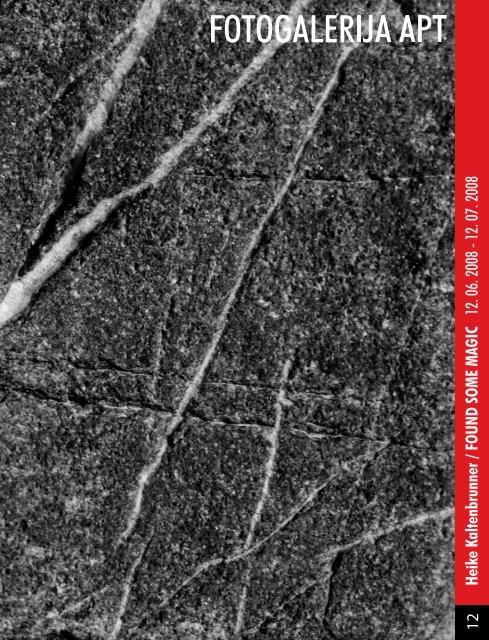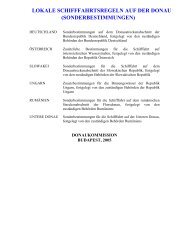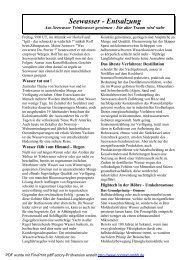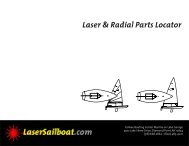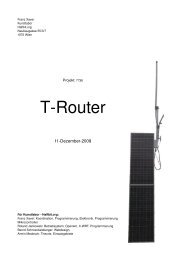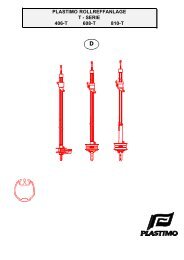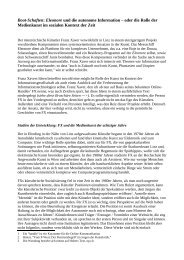Heike Kaltenbrunner / FOUND SOME MAGIC 12. 06. 2008 - 12. 07 ...
Heike Kaltenbrunner / FOUND SOME MAGIC 12. 06. 2008 - 12. 07 ...
Heike Kaltenbrunner / FOUND SOME MAGIC 12. 06. 2008 - 12. 07 ...
You also want an ePaper? Increase the reach of your titles
YUMPU automatically turns print PDFs into web optimized ePapers that Google loves.
<strong>Heike</strong> <strong>Kaltenbrunner</strong> / <strong>FOUND</strong> <strong>SOME</strong> <strong>MAGIC</strong> <strong>12.</strong> <strong>06.</strong> <strong>2008</strong> - <strong>12.</strong> <strong>07</strong>. <strong>2008</strong><br />
12
<strong>Heike</strong> <strong>Kaltenbrunner</strong> / <strong>FOUND</strong> <strong>SOME</strong> <strong>MAGIC</strong><br />
Odprtje Opening: <strong>12.</strong><strong>06.</strong><strong>2008</strong><br />
Trajanje Duration: <strong>12.</strong><strong>06.</strong><strong>2008</strong> - <strong>12.</strong><strong>07</strong>.<strong>2008</strong><br />
<strong>Heike</strong> <strong>Kaltenbrunner</strong> A<br />
Koprodukcija z Co-produced by Hiša fotografije House of Photography, Slovenia<br />
Projektni vodja Project Manager: Bojan Radovič<br />
Koordinator projektov v APT APT project coordinator: Danijel Brezovar<br />
Antropologija kozmičnega. Človeška zavest v očeh <strong>Heike</strong> <strong>Kaltenbrunner</strong>.<br />
Irina Tchmyreva<br />
Z umetnostjo <strong>Heike</strong> <strong>Kaltenbrunner</strong> sem se prvič srečala pred nekaj leti na razstavi Portfolio Review v Bratislavi.<br />
Bilo je nekaj posameznih fotografij, razstavljenih na mizi. Kamni? Struktura granita? Morda so žile ali<br />
mikroskopski fosili, povečani do razpoznavnosti; morda gre za živ organizem in ga dojemam kot mrtvo stvar<br />
le zaradi negibnosti fotografije? Morda pa so to v času ujete sledi premikanja množice nebesnih teles, ki me<br />
s svojo podobo le spominjajo na živ organizem? Že v naslednjem trenutku so se mi pričele porajati številne<br />
asociacije na Dune in podobne znanstveno-fantastične filme. Začutila sem, da sem končno naletela na podobe,<br />
v katerih se znanost in umetnost združita v celoto.<br />
Strukture, ki so zrasle v črno-belih fotografijah <strong>Heike</strong> <strong>Kaltenbrunner</strong>, so posledica njenega navdušenja za<br />
znanost in njenega dojemanja kreativnosti na način laboratorija. Je to duh dvajsetih let dvajsetega stoletja?<br />
Nemara bi kdo lahko rekel, da v teh delih zaznavamo navdušenje za kibernetiko in digitalne modele vesolja<br />
z obdobja od šestdesetih do osemdesetih let preteklega stoletja. Na tem mestu bi bilo prav tako primerno<br />
priklicati si v spomin alkimiste in zdravnike izpred tisoč let, ki so dojeli (izkusili?) popolno enost človeka in<br />
kozmosa, povezanost in medsebojne odnose med dvema modeloma in so se zavedali, da je človek model<br />
vesolja na mikrokozmičnem nivoju, istočasno pa makrokozmos v odnosu na procese, ki se odvijajo v njegovem<br />
tkivu, kosteh, v zemlji in prahu, prav tistem prahu, iz katerega je nastal človek.<br />
Naslednji projekt <strong>Heike</strong> <strong>Kaltenbrunner</strong>, ki sem ga videla, je bil inštalacija, narejena s TV ekrani. Zvok, ki<br />
‘’stiska’’ sliko v svetlobno točko, zvok, ki dobesedno uničuje mehanično srce naprave, ki prenaša sliko. Ali pa<br />
se, obratno, zvok poraja v procesu razničenja slike, ko se podoba spreminja v ozek trak (žarek) svetlobe? Ton;<br />
globok ubran notranji basovski zvok, dobro uglašen in temačen, nedoumljiv, kot zvok vibracij živega organizma<br />
ali pa celo zvok vesolja. Spominja na pradavne rituale šamanov, ki vpliv na svojo okolico udejanjajo z zvokom.<br />
Občutljive vibracije svet spreminjajo v ekran in vračajo zvok v točko njegovega nastanka, medtem pa slika na<br />
ekranu, kot nežna školjka zadrhti od zvoka, se v nekem trenutku zruši sama vase ter tako nakaže prehod med<br />
vidnim in tistim, kar je onkraj meja vidnega.<br />
Gledano s stališča zgodovine umetnosti, delo <strong>Heike</strong> <strong>Kaltenbrunner</strong> brez dvoma nadaljuje tradicijo Nam Jun<br />
Paika in avstrijskega umetnika Franza Xaverja, ki ju umetnica navaja kot svoja duhovna učitelja.<br />
Toda njena inštalacija razmerij med zvočnim signalom in svetlobo, ki se seseda sama vase kot svetloba v<br />
črni luknji, na zaslonu ustvarja nekakšen zaključek na novem nivoju. Zvok, ki ga slišimo ob inštalaciji, je<br />
človeškemu ušesu celo nekako prijazen, podoben tistemu, ki ga proizvajajo oddaljene zvezde, kadar jih s<br />
pomočjo sodobne tehnologije uspemo poslušati v astronomskem observatoriju. To je zvok vesolja, ki človeka ne<br />
odbija in zavrača, saj tudi človek izvira iz kozmosa. Toda ta zvok, ki v svojo kozmično harmonijo vključuje tudi<br />
človeka in ga sprejema (tu se uresničuje Pitagorovo upanje, da se bo nebesna glasba nekoč spustila v zemeljske<br />
sfere), je izredno neljub in nevaren napravam, ki jih je naredila človeška roka – ta zvok jih preprosto uničuje.<br />
Slika se na zaslonu naprave ‘’sesede vase’’ tako hitro po zvoku, da teh dveh procesov v času ne moremo<br />
medsebojno razločiti. Nizkofrekvenčno vibrirajoče bučanje postane zvok smrti naprave – tako vzrok in posledica<br />
tu zamenjata svoji vlogi.<br />
Ko govorimo o stroju, kot delu človeških rok, lahko le obžalujemo dejstvo, da ta stroj v večini svojih pojavnih<br />
oblik, celo androidnih, še zdaleč ni podoben svojemu stvaritelju. Seveda razumemo logiko zasnove in oblike, ki
sledi funkcionalnosti naprave in se udejanja v njeni mehanični zgradbi in zunanji obliki, povzemajoči notranje<br />
organe stroja in zasnovane glede na njen tehnični namen. Če torej na tak način projiciramo zunanjo odvisnost<br />
podobe človeka od njegove notranje strukture, lahko dojamemo, da po vsej verjetnosti tudi človek po svoji<br />
pojavi in videzu še zdaleč ni podoben svojemu stvaritelju.<br />
In kaj dandanes pravzaprav človeštvo postavlja v ospredje svojega bistva? Zavest. In kakšno obliko sploh<br />
ima človeška zavest? Ali se morebiti ne bi prav lahko izkazalo, da je naša zavest le pojava in videz, in da<br />
njena oblika ni prav v ničemer podobna svojemu dejanskemu praliku? To so sicer misli, kvečjemu primerne za<br />
kak znanstvenofantastični scenarij o oblikah življenja. Toda prav te in take misli se nam porajajo ob ogledu<br />
projekta <strong>Heike</strong> <strong>Kaltenbrunner</strong>. In niti ni tako zelo pomembno, če so forme na njenih zaslonih (lokatorji zvoka in<br />
nosilci podobe) pravokotne z jasnimi geometrijskimi linijami ali nežno zaobljene v organske, biomorfne oblike.<br />
Projekti <strong>Heike</strong> <strong>Kaltenbrunner</strong> nam govorijo o človeški zavesti, procesih zavedanja in kozmičnih razmerjih med<br />
majhnostjo in velikostjo. Pa še o kozmičnosti, ki je že od nekdaj najpomembnejša tema umetnosti. Nekoč se<br />
je kozmičnost utelešala v religioznih simbolih, dandanes se odeva v tehnokratsko formo in prav mogoče je, da<br />
bo ta tema nekoč, sčasoma, prevzela antropomorfno, človeško obliko. Vendar pa do takrat človeška zavest še<br />
vedno ostaja zaprta v ustaljenih konvencionalnih mehaničnih okvirjih, antropologija pa predstavlja le model<br />
sodobnega umetniškega tehničnega modeliranja.
The anthropology of the cosmic. <strong>Heike</strong> <strong>Kaltenbrunner</strong>’s consciousness.<br />
By Irina Tchmyreva<br />
We – the art of <strong>Heike</strong> <strong>Kaltenbrunner</strong> and I – became acquainted for the first time at the portfolio review in<br />
Bratislava a few years ago. It all began from separate photographs, laid out on a table. Stones? Textures of<br />
granite? Or veins; fossils of miniscule sizes magnified to the size of the visible; or they are alive, and only<br />
the stillness of the photograph makes them motionless? Maybe they are the traces, captured in time, of the<br />
movement of heavenly bodies, travelling in multitudes and thus reminding one of live organisms? “Dune” and<br />
associations with many other fantasy films flood in instantly, ultimately leaving a strong feeling that one had<br />
come across images in which science and art had become a single whole.<br />
The textures, which have grown in the black and white photographs of <strong>Heike</strong> <strong>Kaltenbrunner</strong> – are due to her<br />
enthusiasm for science and her understanding of creativity as a laboratory. Is it the spirit of the 20s of the<br />
20 th century? One can say that there is in this – an enthusiasm for cybernetics and the digital models of the<br />
Universe of the 1960-1980s. It is fashionable to recall the alchemists and physicians of a thousand years ago,<br />
who comprehended (experienced?) the total unity of man and the cosmos, the joining and interrelation of two<br />
models, especially knowing that man is the model of the Universe on a micro scale and simultaneously – the<br />
macrocosm in relation to processes going on in his tissues, in stones and in the earth, in that dust out of which<br />
man is born.<br />
The next project I saw by <strong>Heike</strong> <strong>Kaltenbrunner</strong> was an installation made out of TV screens. Sound, “pulling<br />
together” the image into a point of light, sound, destroying the mechanical heart of the machine transmitting<br />
the image. Or is it, the reverse, the process of the annihilation of the picture, transforming it into a narrow light<br />
flow (ray) that gives birth to sound? Musical sound, not cacophonic, but a deep bass, well-tempered profound<br />
internal sound, which can be created by a living organism through its vibrations, or the sound of the Universe.<br />
It reminds one of ancient ritual practices – Bon, shamans, whose influence on the world is practically realized<br />
with the help of sound, the vibration on fine levels, making the world turn into a screen, returning sound to the<br />
point of origin, the screen, which, like a fine shell, begins to shudder from the sound, shudder and… at one<br />
moment the screen is ready to collapse, having shown the possibility of transition between the visible and that<br />
which is beyond its limits.<br />
There is no doubt that from the point of view of the history of art, <strong>Heike</strong> <strong>Kaltenbrunner</strong>’s work continues the<br />
tradition of Nam Jun Paik and the Austrian artist Franz Xaver, whom the artist considers her spiritual teachers.
But her installation of the relations between the sound signal and light, curling inwards, like light within a black<br />
hole, on screens creates a generalization on a new level. The sound, which you hear in the installation, is even<br />
pleasing to the human ear, it is similar to the sounds made by the distant stars, when one succeeds in hearing<br />
them in an astronomical observatory. This is the sound of the cosmos, not rejecting man, who – may be of<br />
cosmic origin. And this sound, integrating man into the cosmic harmony (thus Pythagoras’ hope for the descent<br />
of the heavenly music of the spheres onto worldly affairs is being fulfilled), is extremely dangerous for manmade<br />
mechanisms, it kills them. But the process of the image’s “inward curling” on the screen of the machine takes<br />
place so quickly after the sound, that we cannot visually separate them in time. The low frequency vibrating<br />
boom becomes “the sound” of the machine’s death. Cause and effect substitute one another.<br />
Speaking of the machine as the creation of man, we regret that the majority of its forms, even androids, are<br />
extremely far from being similar to their creators. We understand the logic of the design, which follows the<br />
machine’s function, realised in its mechanical structure, the design by the external covering summarizes the<br />
machine’s “internal organs”, arranged in accordance with the engineering purpose. Projecting onto man the<br />
external appearance’s dependence on the internal structure, we must understand that he, created “in the image<br />
and likeness” of his creator, perhaps, is just as far from external similarity with him.<br />
Today, what does humanity define as being its essence? – Consciousness. What form does consciousness have?<br />
Is it not possible that it may turn out that our consciousness is the image and likeness, and the form, into which<br />
it is placed, has no similarity with the prototype? These thoughts are suitable for the scenario of a fantasy<br />
work about the forms of life. But these thoughts – were born from the contemplation of <strong>Heike</strong> <strong>Kaltenbrunner</strong>’s<br />
project. It is not so important whether the forms of her screens (the locators of sound, the translators of image)<br />
are right-angled with sharp geometric lines – or organic soft biomorphic ones. <strong>Heike</strong> <strong>Kaltenbrunner</strong>’s projects<br />
are about consciousness, the process of consciousness, the relation of cosmically great and small scales. About<br />
the cosmic – the most important theme in art. Once it was embodied in the form of religious symbols, now this<br />
theme has acquired technocratic forms, possibly, this theme may, at some time, acquire an anthropomorphic<br />
form. But for the meanwhile – consciousness is enclosed in the conventional mechanical covering. Anthropology<br />
as a model on the contemporary level of technical artistic modelling.<br />
Translated from Russian by P. Glebov and R. O’Dowd.
Anton Podbevšek Teater<br />
Prešernov trg 3,<br />
8000 Novo mesto, Slovenija<br />
T. +386 (0)7 391 78 10<br />
F. +386 (0)7 391 78 12<br />
www.antonpodbevsekteater.si<br />
info@antonpodbevsekteater.si<br />
Koprodukcija/Co-production:<br />
Hiša fotografije/House of Photography<br />
Slovenija<br />
www.hfs.si


